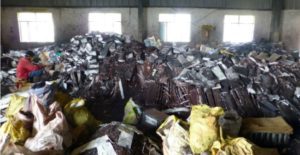This is the second post from Sarita Gupta, Blacksmith’s India director, from her recent trip visiting lead smelters in India.
I work for Blacksmith Institute, which cleans up toxic pollution around the world. I never imagined sitting in my New York office that an occupational hazard would be to get showered in lead dust.
I was on a visit to three lead smelters in India, accompanying a Blacksmith expert who is helping them to assess how environmentally sound they are, and what they can do to create safer conditions for their workers as well as the surrounding communities. Our lead shower took place at smelter No. 2.
My first instinct was to flee but then I glanced at Brian Wilson, who has worked around lead for 33 years and is militant about protecting himself and anyone with him. Brian looked completely calm and did not take even a step to get out of the way of the dust shower. That was because we were all wearing masks to prevent inhalation of this toxin.
Smelter workers in general were not as well protected. We saw many in sandals whereas Brian made sure the smelter managers gave us sturdy boots to wear around the plant. There apparently aren’t many women visitors (or workers) at one plant, and they gave me the smallest shoe size in men’s, which I held up by tying the laces around my ankles. The worker who was moving ingots of finished lead from the belt and stacking them by hand a few feet away fascinated me. I imagined the 25 kg weight falling on his bare toes and finishing off his work life. Others had their mandatorily-provided face masks dangling from their necks. The masks were itchy and it was hard to breathe in the heat of the Indian summer, so it was easy to think one was immune.
Till it showered lead.

The shower was due to Brian asking to check the functioning of a bag house. The worker turned the switch to BLOW instead of SUCTION. Which raised the question of training and education. Unfortunately, for a smelter owner, the training should not end with his/her plant workers.
The villagers around one plant were up in arms because nine cows had died from lead poisoning. The smelter checked the levels of its fugitive emissions from its furnace: negligible. After much investigation it was surmised that the lorries bringing used car batteries to the smelter would, after unloading, go to a pond down the road and wash out their cabs. The cows drank from that pond and got poisoned. How much the truck drivers knew about the risks of their cargo to themselves and other humans is an open question.

While the U.S. and Europe have become wise to the dangers of lead, emerging markets have yet to wake up. All three smelters are trying to do their best to protect their workers and communities even if the standards are not what we might expect. The bigger issue in India is the number of illegal operators who break apart lead acid batteries in their back yards, dumping sulfuric acid and vast quantities of lead into the soil and air. By doing so they are compromising not just their health but condemning their children to irreparable brain and neurological damage.
The lead dust settled on our clothes and hair. On the way back to the hotel, Brian handed each of us a plastic bag and instructed us to shed the clothing immediately upon entering our rooms, seal it in the bag and keep it separate from all our other stuff until it could be washed.
If only someone was taking such care of the workers we met on this trip.





